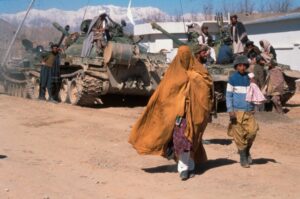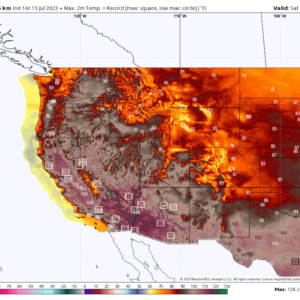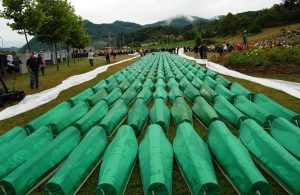By Julien de Troullioud de Lanversin, Christopher Fichtlscherer, March 7, 2024
In the past, countries used full-yield nuclear tests to verify the performance of their nuclear warheads, develop new warhead designs, expand their grasp of nuclear weapon physics, and even explore so-called peaceful uses of nuclear explosions. (The yield of a nuclear explosion refers to the energy that is released by fission of the fissile material in the nuclear weapon.) These tests were initially conducted in the atmosphere, the ocean, and space, but mounting concerns about radioactive contamination of the environment forced countries to conduct testing underground after the Partial Test Ban Treaty entered into force in 1963. Three decades later, negotiations were convened in Geneva on a treaty that would ban all types of nuclear weapon tests. In 1996, the UN General Assembly adopted the Comprehensive Nuclear Test Ban Treaty (CTBT), now ratified by 177 countries.
Because several required states have not ratified the treaty (including the United States, China, and now also Russia, which withdrew its ratification in 2023), it has not yet entered into force. According to the Vienna Convention on the Law of Treaties, however, states must follow the provisions of treaties they have signed (Vienna Convention on the Law of Treaties 1969). Since 1998, all nuclear powers except North Korea have observed a moratorium on nuclear weapon tests. Headquartered in Vienna, the Comprehensive Nuclear Test Ban Treaty Organization is responsible for verifying the implementation of this moratorium and preparing for the future entry into force of the treaty by supervising the International Monitoring System, a global network of monitoring stations and laboratories aimed at detecting nuclear explosions, including those conducted underground.
References
Besnard, D. 2006. The Megajoule Laser–A High-Energy-Density Physics Facility. In: Schwoerer, H., Beleites, B., Magill, J. (eds) “Lasers and Nuclei.” Lecture Notes in Physics, vol 694. Berlin: Springer. https://doi.org/10.1007/3-540-30272-7_5
Bugos, S. 2020. “Trump administration debates resuming nuclear testing.” Arms Control Association. June 4. https://www.armscontrol.org/blog/2020-06-04/trump-administration-debates-resuming-nuclear-testing
Cheung, E., B. Lendon, and I. Watson. 2023. “Exclusive: satellite images show increase activity at nuclear test sites in Russia, China and US.” CNN. September 23. https://edition.cnn.com/2023/09/22/asia/nuclear-testing-china-russia-us-exclusive-intl-hnk-ml/index.html.
Funk, D. J. 2019. “Enhanced Capabilities for Subcritical Experiments (ECSE): Portfolio Overview.” Los Alamos National Laboratory, LA-UR-18-28253. March 11. p. 46. https://permalink.lanl.gov/object/tr?what=info:lanl-repo/lareport/LA-UR-18-28253.
Hecker, S. S., ed. 2016. “Doomed To Cooperate: How American and Russian Scientists Joined Forces to Avert Some of the Greatest Post-Cold War Nuclear Dangers, Volume 1” Los Alamos, NM: Bathtub Row Press.
Hruby, J. 2023. “Remarks at the CTBT Science and Technology Conference 2023.” National Nuclear Security Admnistration. June 19. US Department of Energy. https://www.energy.gov/nnsa/articles/remarks-nnsa-administrator-jill-hruby-ctbt-science-and-technology-conference-2023
IAEA. 2003. “Safeguard techniques and equipment.” International Nuclear Verification Series No. 1 (revised). International Atomic Energy Agency. pp 36-60. https://www-pub.iaea.org/MTCD/Publications/PDF/NVS1-2003_web.pdf
Isachenkov, V. “Russia suspends only remaining major nuclear treaty with US.” AP News. February 21. https://apnews.com/article/russia-ukraine-putin-politics-government-united-states-23cc21a1f42798177a40d4e53204b054
JASON. 1994. “Science Based Stockpile Stewardship.” JSR-94-345, MITRE Corporation. November.https://programs.fas.org/ssp/nukes/testing/jsr94345stckplstwdshp.pdf
MacFarquhar, N. 2023. “Russia pulled out of a nuclear test ban treaty. Here’s what that means.” The New York Times. November 2. https://www.nytimes.com/2023/11/02/world/europe/russia-nuclear-test-ban-treaty.html
Mikhailov, V. N., et al. n. d. “Nuclear tests of USSR hydronuclear experiments. Plutonium consumption stock-taking.” https://inis.iaea.org/collection/NCLCollectionStore/_Public/29/067/29067933.pdf
National Research Council. 2012. The Comprehensive Nuclear Test Ban Treaty: Technical Issues for the United States. Washington, DC: The National Academies Press. P 104. https://doi.org/10.17226/12849
Osborn, A. 2023. “Russia accuses US of nuclear testing site activity, says it won’t test unless US does.” Reuters. October 11. https://www.reuters.com/world/russia-would-only-resume-nuclear-testing-when-us-does-agencies-2023-10-10/
Strömbom, J. 2021. “Natural Fingerprinting of Steel,” Luleå University of Technology. https://www.diva-portal.org/smash/get/diva2:1568687/FULLTEXT01.pdf
Tolk, K. M. 1992. “Reflective Particle Technology for Identification of Critical Components.” INMM Annual Meeting. https://www.osti.gov/servlets/purl/7116334
de Troullioud de Lanversin, J., C. Fichtlscherer, and F. N. von Hippel. 2021. “Onsite Verification of the Comprehensive Nuclear Test Ban Treaty at Very Low Yields.” INMM & ESARDA Joint Annual Meeting.https://resources.inmm.org/sites/default/files/2021-09/a325.pdf
US Defense Department. 1996. “DoD Nuclear Weapon System Safety Program Manual.” DoD 3150.2-M. December. https://www.hsdl.org/?view&did=501
US Department of State. 2011. Key P5 Public Statements on CTBT Score. https://2009-2017.state.gov/t/avc/rls/173945.htm#:~:text=%E2%80%9CThe%20Treaty%20prohibits%2C%20in%20effect,%2C%20no%20nuclear%20chain%20reaction.%E2%80%9D
US Department of State. 2013. Scope of the Comprehensive Nuclear Test-Ban Treaty. https://2009-2017.state.gov/t/avc/rls/212166.htm
US Department of State. 2019. “Adherence to and compliance with arms control, nonproliferation, and disarmament agreements and commitments.” Compliance-Report-2019-August-19-Unclassified-Final.pdf (state.gov)
US Government Accountability Office. 2023. “Program Management Improvements Would Benefit U.S. Efforts to Build New Experimental Capabilities,” GAO-23-105714. https://www.gao.gov/assets/d23105714.pdf
Vienna Convention on the Law of Treaties. 1969. 1155 U.N.T.S. 331, art. 18. https://legal.un.org/ilc/texts/instruments/english/conventions/1_1_1969.pdf
Keywords: Nuclear arms control; CTBT; subcritical tests; nuclear weapon tests; confidence-building measures
Topics: Nuclear Risk, Nuclear Weapons




